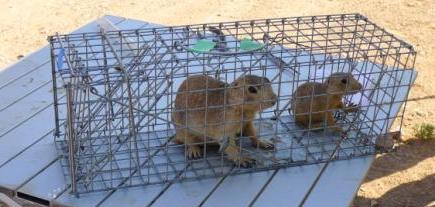Sevilleta staff biologist Jon Erz confers on trap locations with Jackie
Albert, an intern with the Student Conservation Association from
New York. Albert has collected two traps containing prairie dogs.
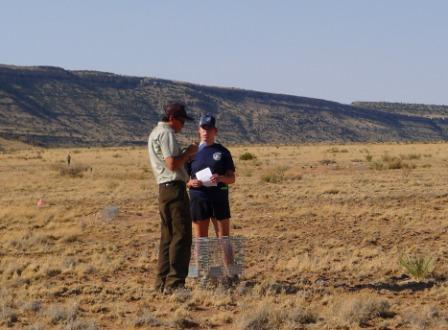
It’s the rare happy story in a chronicle of sadness. Gunnison’s Prairie Dogs, once plentiful across the West but decimated by a century of poisoning, trapping, shooting, and habitat loss, have a little Eden of safety at Sevilleta Wildlife Refuge, north of Soccorro.
It’s purely artificial, of course. You don’t shrink from a universe of 5 billion creatures to 1 percent of that with any hope of rebounding. The vast grasslands that hosted their amazingly complex burrows—prairie dog “towns”—have nearly vanished, like their ecological partners, the American Bison, the Black-Footed Ferret, the Burrowing Owl. In tiny pockets of open space where
the tunneling rodents persist, ranchers and governments want them gone.
So the prairie dog story is not one of recovery, but of rescue. Small but devoted rescue groups like the Albuquerque-based Prairie Dog Pals work to remove prairie dogs from populated areas where they are not wanted, and relocate them to Sevilleta.
Here on this 230,000-square-mile refuge, prairie dogs are wanted. That’s because the rodents are a “keystone” species—one that plays a critical role to the health of an ecosystem. Besides helping to feed predators, prairie dogs are among nature’s engineers. Their burrows fertilize and aerate the soil, promote vegetation growth and diversity, channel rainwater, and provide nesting habitat for a dozen or more species. So their presence perfectly suited the goals of Sevilleta, which exists primarily for ecosystem restoration. Much of the refuge is essentially a research station for the University of New Mexico.
The gift of a rancher who recognized the harm done to New Mexico by grazing, Sevilleta is now part of the federal refuge system and administered by the U.S. Fish & Wildlife Service. Public access is limited, in favor of maintaining and enhancing the natural character of its ecosystems.
Since 1988, Sevilleta has been among 26 sites nationwide known as the Long Term Ecological Research Network (LTER), where scientists study such things as the effects of climate, fire, and water on different environments. UNM researchers thus proposed bringing back prairie dogs as a vital player in the Great Plains grassland ecosystem. In 2005, they enlisted the help of a Santa Fe rescue group to release 300 prairie dogs on 7.5 acres of grassland.
Based on that experiment, the project was ramped up in 2010, after Sevilleta biologist Jon Erz joined the staff. Working with the UNM team, he oversaw a much larger release, some 600 dogs over 80 acres, in the hopes that the animals would start to colonize and spread.
Prairie dogs were once plentiful at Sevilleta, and ironically it was an animal control officer who formerly exterminated them from the range who identified where they had thrived, in the shadow of the Los Pinos range.
But city dogs don’t always have an easy time of it when they move back to the country.
“I think of the first ones as ‘pioneers,’” he adds, “and the ones that follow take advantage of that established infrastructure.”
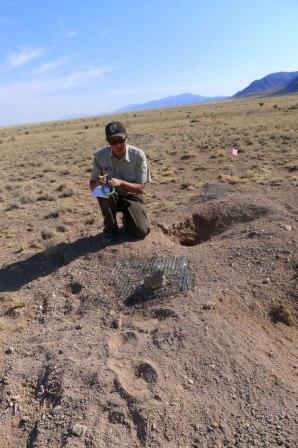
On this already-hot summer morning, Erz and his crew of interns plus a crew of researchers from the LTER are doing one of their annual prairie dog counts. For three days each in spring and summer, they set 300 traps on representative sections of prairie dog refuge, and count what gets caught—gender, weight, etc. That gives them a picture of how the reintroduction effort is going.
Today is day three, so the count is not nearly as high as on day one, when 27 dogs took the bait of sweet oats and corn. In fact, a fair number of the dogs turn out to be repeat offenders from yesterday, suggesting that they’re savvy to the routine of being caged and handled in exchange for a dietary treat.
Last year’s census turned up pups for the first time—a sign that the dogs are thriving well enough to reproduce. Releases of new dogs were thus scaled back to 300 last year, and may vary this summer, depending on population estimates. “But we are committed to augmentation,” Erz adds, “because during drought years especially, the decline can be quite steep, and then you’re essentially starting over. The first five years are very important.”
The refuge has committed to managing the prairie dog reintroduction for five years—through 2014—arranging with Prairie Dog Pals to trap and relocate animals that would otherwise be exterminated, like colonies found on highway medians, vacant lots, and construction sites. Volunteers bring the captured dogs to a holding facility in Albuquerque so they can be weighed, tagged, and quarantined to ensure none have plague. Then volunteers drive them to Sevilleta.
At that point, it takes a number of days to settle them into their new home. Volunteers, Erz, and the LTER researchers initially release the dogs into artificial burrows planted four feet into the ground. The newcomers are then fed for the first few days so they can get their bearings.
The effort is paying off, as evidenced by the broad smiles of the Sevilleta crew after three days of trap-setting at 5 a.m. Hit hard by predators in year one—badgers, hawks, snakes, and coyotes—the prairie dogs are now surviving and thriving. Populations have increased, burrows are spreading, and improvements are being seen in the diversity of surrounding vegetation compared with adjacent private rangeland. Despite some initial scuffles, each wave of prairie dog newcomers has integrated into its new town, and begun sharing DNA with residents.
“It’s a great example of management,” Erz says with satisfaction. “We’re bringing in this species, and they can’t rebound naturally, but the hope is that they will eventually develop on their own.” Which is precisely the mission at Sevilleta.
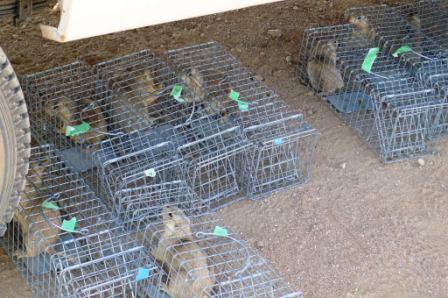
Prairie dogs captured on day three of the June census await processing in the shade of a truck. Most lapse into a silent daze, but one barks continuously in warning. Prairie dog vocalizations are among the most complex known. They can distinguish among predators, describing their appearance and behavior. Much is still not understood about their jumps, yips, tail flagging, and social chatter.
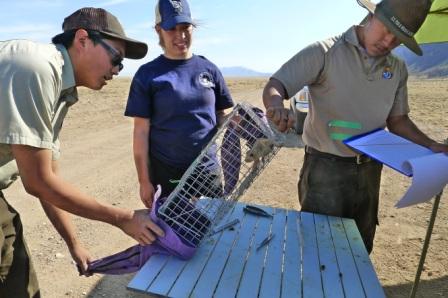
To weigh a captured prairie dog, intern Aaron Cajero from Jemez Pueblo coaxes the creature into a cloth bag, which is then suspended from a scale.
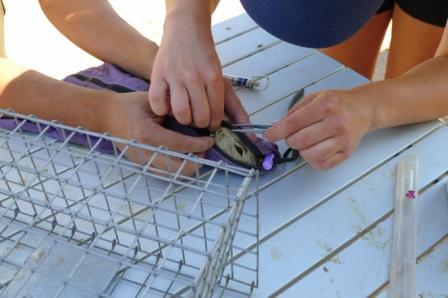
A prairie dog whose ear tag has fallen out is held still in the bag as intern Jackie Albert tries attaching a new one.
To help prairie dogs, contact Prairie Dog Pals at (505) 296-1937 or by email.

